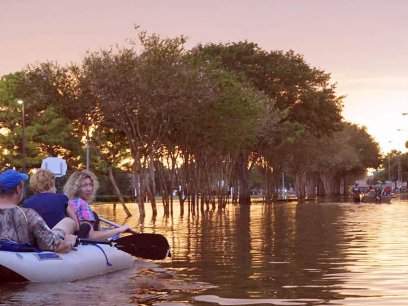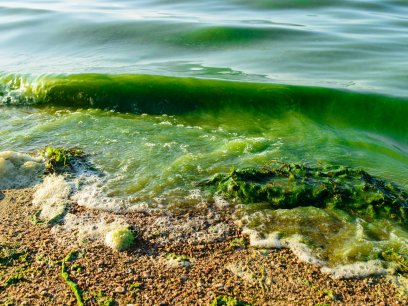
Slow-Down not Unusual or Unexpected; Impacts of Warming Known to be Nonlinear
The rapidly rising temperature increases in most of the last three decades of the 20th century have slowed since around 1998, but the warming slow-down is nothing scientists find surprising or see as an indicator of the Earth’s future climate given energy trends now on the horizon.
From the early 1970s through 1998, global mean surface temperatures rose steadily. Since 1998, however, the rate of increase has slowed substantially, notwithstanding continuing emissions and growing atmospheric concentrations of greenhouse gases. And notwithstanding also the continuing retreat of Arctic sea ice and thinning of glaciers, and continuing warming and increased acidification of oceans as they absorb more carbon dioxide from the atmosphere.
The slow-down in the rate of surface warming – mistakenly referred to in some cases as a “pause” despite the continued, though slower, warming – has led some to claim, and some media outlets to report, that global warming actually ended in 1998.
The actual observed increase in surface temperatures clearly has slowed, but not stopped, since 1998. (The same is not true of the oceans, which command more than 70 percent of Earth’s surface.) The three most-cited datasets estimating average land surface temperature all show warming over the last 15 years (180 months): GISS 0.11°C, HadCRUT4 0.07°C and NCDC 0.07°C (0.2, 0.13 and 0.13°F, respectively). Clearly a slowdown from the per-decade warming rates of about 0.15 to 0.20°C (0.27 to 0.36°F) of the 1980s and first half of the 1990s. And it’s a slowdown that computer models of that earlier period had not anticipated.
- What does the peer-reviewed scientific literature have to say on the subject?
- Effects Will Be Nonlinear…and We’ll Still Always Have Weather
- U.K.’s Met Office Reports and Analyses
- Scientists’ Discussions of the Hiatus
- References and Resources
What does the peer-reviewed scientific literature have to say on the subject?
In a research paper published August 28, 2013 in Nature, scientists Yu Kosaka and Shang-Ping Xie of the Scripps Institution of Oceanography wrote that “the current hiatus is part of natural climate variability, tied specifically to a La Niña-like decadal cooling. Although similar decadal hiatus events may occur in the future, the multi-decadal warming trend is very likely to continue with greenhouse gas increases.” (This Scripps Institution research was funded by NOAA’s Climate Program Office, the National Science Foundation and the National Basic Research Program of China.)
Effects Will Be Nonlinear…and We’ll Still Always Have Weather
The slow-down since 1998 illustrates – and perhaps even puts an exclamation point on – a principle that climate scientists often emphasize. It’s one that the public might not readily understand: The effects of climate change, and specifically the temperature impacts, will be non-linear. We’ll continue to have weather while we have climate change, aka global warming. That is, there will continue to be some abnormally warm February and March days in our future, and also some unusually cool June and July days. Neither will tell us much about long-term climate change. It’s the overall average and long-range temperatures that are projected to continue to climb. In addition, the number of record high local temperatures is expected to increase and the ratio between record highs and record lows in specific places is expected to grow larger.
The point is worth emphasizing: It’s the overall trend – not what happens on a specific day or week (or month or year or even decade) – that counts. Or, for that matter, what happens in a specific location, city, region, or even country or continent over the short term.
Research by climate scientist Gerald Meehl and colleagues with the National Center for Atmospheric Research (NCAR), in Boulder, Co., indicate that deep ocean sectors have continued to warm during the surface temperature “hiatus,” in effect soaking-up the missing atmospheric heat. Their research indicates that the slow-down in warming of the global land surface may result from La Niña events – six of them since 1998 – that can lead to some cooling in the eastern tropical Pacific.
U.K.’s Met Office Reports and Analyses
Among those organizations addressing the 1998-2013 warming slow-down (a term considered more literally accurate than “pause”) is the United Kingdom’s Met Office, which has written a series of reports on the issue. The Met Office’s September 2013 verbatim summary of its three reports:
The first paper shows that a wide range of observed climate indicators continue to show changes that are consistent with a globally warming world, and our understanding of how the climate system works.
The second suggests that it is not possible to explain the recent lack of surface warming solely by reductions in the total energy received by the planet, i.e., the balance between the total solar energy entering the system and the thermal energy leaving it. Changes in the exchange of heat between the upper and deep ocean appear to have caused at least part of the pause in surface warming, and observations suggest that the Pacific Ocean may play a key role.
The final paper shows that the recent pause [Note that even the Met Office used the “pause” meme] in global surface temperature rise does not materially alter the risks of substantial warming of the Earth by the end of this century. Nor does it invalidate the fundamental physics of global warming, the scientific basis of climate models and their estimates of climate sensitivity.
The authors of the Met Office reports say their research suggests that warming previously projected to occur by 2050 will be delayed by only a few years as a result of the 15-year warming slow-down, though no one at this point can say with confidence just how long this current slow-down might continue.
The Met Office’s reference to the potential role of cooling of the Pacific Ocean reinforces a point from the Yosaka/Xie research referred to above: “Accounting for recent cooling in the eastern equatorial Pacific reconciles climate simulations and observations.”
In its conclusion to the first of those three 2013 reports, the Met Office wrote “periods of slowing down and pauses in surface warming are not unusual in the instrumental temperature record.” It added that climate model simulations “suggest that we can expect such a period of a decade or more to occur at least twice per century” simply as a result of internal variability alone. And it wrote that “recent research suggests that ocean heat re-arrangements, with a contribution from change in top of the atmosphere radiation, could be important” in explaining warming slow-down that began in 1998.
At the same time, the Met Office wrote that the slow-down demonstrates a “need for better continuous long-term records of the net radiation at the top of the atmosphere in general, and of solar radiation in particular, to understand decadal changes in global climate.” It urged monitoring of deep ocean levels, below 2,000 meters (6,562 feet), using in situ measurements to build on advances resulting from extensive use of Argo floats. And it underscored the need for in-depth understanding of global ocean dynamics “and how this acts to rearrange heat within the system,” emphasizing the need for better understanding decadal variability in the Pacific Ocean.
Scientists’ Discussions of the Hiatus
So, one might ask, what led to the cooling of the tropical Pacific in the first place? Among those seeking answers is MIT scientist Susan Solomon: “Did the sea surface temperatures cool on their own, or were they forced to do so by, for example, changes in volcanic or pollution aerosols, or something else?”
Pollution aerosols? That is an issue raised also by a team of researchers led by Boston University scientist Robert Kaufmann. In 2011, those researchers pointed to surging, and widely publicized, increases in urban area air pollution in China as a result of growing coal combustion, leading to a dense blanket of particulate air pollution, or smog, in Beijing and other major cities and parts of the country. Those aerosols have been shown to counteract, though only for a period of time and not over the long-term, warming resulting from increased emissions and concentrations of greenhouse gases in the atmosphere.
Emphasizing that he does not find recent surface temperature trends to be especially unusual, University of Chicago planetary climatologist Raymond Pierrehumbert cautions that “the term ‘hiatus’ is premature. Maybe with another 10 years of data you’d say that’s something that needs explanation.”
And commenting on the warming slowdown and on the nonlinear nature of climate change effects, National Academy of Science Member Ben Santer, a climate modeler at Lawrence Livermore National Laboratory in California, says, “Our expectation has never been that each year would be inexorably warmer than the previous year.”
Santer rejects as scientifically unsupportable the notion that gaps between climate model projections and actual observations result from overestimating the sensitivity of the climate to increased atmospheric greenhouse gas concentrations. Instead, he is curious about early efforts to pin-point the influence of particular components or qualities of the atmosphere: “It’s likely we underestimated the true volcanic aerosol forcing, and may have underestimated the cooling effect of stratospheric ozone depletion.”
Santer says the most reliable temperature measurements of the lower troposphere (below about 10 kilometers (6.2 miles) in altitude) are derived from microwave emissions measured by satellites. These, he says, have true global coverage and are independent of complicating factors like the urban heat island effects that influence thermometers on land surface.
Speaking of the 1998-2013 slow-down in global surface temperatures, Pierrehumbert says “There’s really nothing in this that changes our estimates of climate sensitivity.” Calculation of that all-important number from the 20th century record is not possible, he says, because the aerosol forcing is not well known, nor are the data for ocean warming up to the task. “Any estimate of sensitivity requires all of the record and not just the last 20 years of it,” Pierrehumbert says.
“The smaller the piece of it you take, the less certainty you have in your result.” That’s a point that climate scientists make not only in reference to the period of time but also to the geographic limitations. As important as the Earth’s land surface is – after all, we humans live on it –oceans cover roughly 71 percent of Earth’s surface, so measuring just surface temperature trends amounts to what Pierrehumbert might call a “small piece” of the total puzzle.
That said, Pierrehumbert does agree that some imprecise characterizations of the rate of warming that characterized the final three decades of the 20th century may have been misleading: “I think it’s true that some rather sloppy discussion of the rapid warming from the 20th century has given people unrealistic expectations about the future course of warming.”
That’s a lesson, he says, that climate scientists and other communicators and educators addressing climate change issues can all take to heart and learn from. And it’s a lesson NOAA WCMs and broadcast meteorologists will do well to share with their audiences, along with a more evidence-based overall understanding of “the warming hiatus.”
References and Resources
- Why did Earth’s surface temperature stop rising in the past decade? Climate.gov.
- Held, I.M. (2013), Climate science: The cause of the pause. Nature 501, 318-319.
- Temperature Plateau Likely Due to Deep Ocean Warming. Climate Central. Published July 23, 2013.
- AR5 Working Group I Physical Science Report of the Intergovernmental Panel on Climate Change
- Balmaseda, M. A., K. E. Trenberth and E. Källén (2013), Distinctive climate signals in reanalysis of global ocean heat content. Geophys. Res. Lett., 40, Doi: 10.1002/grl.50382.
- Kosaka Y., and S-P. Xie (2013) Recent global-warming hiatus tied to equatorial Pacific surface cooling. Nature, 501, 403-407, doi: 10.1038/nature12534
- Solomon, S., et al., (2010), Contributions of stratospheric water vapor to decadal changes in the rate of global warming. Science, 327, 1219-1223.
- Trenberth, K. E., J. T. Fasullo, and J. Kiehl (2009), Earth’s global energy budget. Bull. Amer. Meteor. Soc., 90, 311-323.
- Trenberth, K. E., and J. T. Fasullo (2010), Tracking Earth’s energy. Science, 328, 316-317.
- TrenberthK. E., and J. T. Fasullo, 2013: An apparent hiatus in global warming? Earth’s Future. Doi: 10.002/2013EF000165. In press.
- Skeptical Science.com
- Rethinking the ‘Slow-Down’: New Work Revises Warming Estimates Upward, The Yale Forum on Climate Change & The Media, Zeke Hausfather, November 25, 2013
- Reconciling anthropogenic climate change with observed temperature 1998–2008, Robert K. Kaufmann, Proceedings of the National Academy of Science, July 5, 2011
- The Recent Pause in Warming, Met Office, U.K., July 2013
- W[h]ither Global Warming? Has It Slowed Down?, David Appell, The Yale Forum on Climate Change & The Media, May 7, 2013
About the Author
Morris A. (Bud) Ward, editor of Yale Climate Connections, is a proven and widely experienced communicator and educator on environmental, energy and climate change issues. He has an extensive publishing history including hundreds of bylined news and analysis articles and authorship or co-authorship of five professional books. He has conducted numerous first-hand workshops for reporters, editors and policy makers on issues involving journalism/communications, climate change and environmental risk. He writes, speaks and teaches regularly on issues related to climate change and on the changing nature of journalism and mass communications in modern society.


